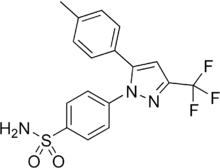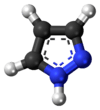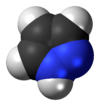Pyrazole
| |||
| |||
| Names | |||
|---|---|---|---|
| Preferred IUPAC name
1H-Pyrazole | |||
| Other names
1,2-Diazole | |||
| Identifiers | |||
| 288-13-1 | |||
| 3D model (Jmol) | Interactive image | ||
| ChEBI | CHEBI:17241 | ||
| ChEMBL | ChEMBL15967 | ||
| ChemSpider | 1019 | ||
| DrugBank | DB02757 | ||
| ECHA InfoCard | 100.005.471 | ||
| KEGG | C00481 | ||
| PubChem | 1048 | ||
| |||
| |||
| Properties | |||
| C3H4N2 | |||
| Molar mass | 68.08 g·mol−1 | ||
| Melting point | 66 to 70 °C (151 to 158 °F; 339 to 343 K) | ||
| Boiling point | 186 to 188 °C (367 to 370 °F; 459 to 461 K) | ||
| Basicity (pKb) | 11.5 | ||
| Except where otherwise noted, data are given for materials in their standard state (at 25 °C [77 °F], 100 kPa). | |||
| | |||
| Infobox references | |||
Pyrazole is an organic compound with the formula C3H3N2H. It is a heterocycle characterized by a 5-membered ring of three carbon atoms and two adjacent nitrogen atoms. Pyrazole is a weak base, with pKb 11.5 (pKa of the conjugated acid 2.49 at 25 °C).[1] Pyrazoles are also a class of compounds that have the ring C3N2 with adjacent nitrogen atoms.[2] Notable drugs containing a pyrazole ring are celecoxib (Celebrex) and the anabolic steroid stanozolol.
Preparation and reactions
Pyrazoles are synthesized by the reaction of α,β-unsaturated aldehydes with hydrazine and subsequent dehydrogenation:[3]
Substituted pyrazoles are prepared by condensation of 1,3-diketones with hydrazine. For example, acetylacetone and hydrazine gives 3,5-dimethylpyrazole:[4]
- CH3C(O)CH2C(O)CH3 + N2H4 → (CH3)2C3HN2H + 2 H2O
History
The term pyrazole was given to this class of compounds by German Chemist Ludwig Knorr in 1883. In a classical method developed by German chemist Hans von Pechmann in 1898, pyrazole was synthesized from acetylene and diazomethane.[5]
Conversion to scorpionates
Pyrazoles react with potassium borohydride to form a class of ligands known as scorpionate. Pyrazole itself reacts with potassium borohydride at high temperatures (~200 °C) to form a tridentate ligand known as Tp ligand:
- KBH4 + 3 C3H3N2H → KBH(C3H3N2)3 + 3 H2
Occurrence and uses

In medicine, derivatives of pyrazoles are used for their analgesic, antinociceptive, anti-inflammatory, antipyretic, antiarrhythmic, tranquilizing, muscle relaxing, psychoanaleptic, anticonvulsant, monoamineoxidase inhibiting, antidiabetic, antifungal, and antibacterial activities.
In 1959, the first natural pyrazole, 1-pyrazolyl-alanine, was isolated from seeds of watermelons.[6][7]
Related heterocycles
Imidazole is an analog of pyrazole with two non-adjacent nitrogen atoms. In isoxazole, another analog, the nitrogen atom in position 1 replaced by oxygen.
References
- ↑ Dissociation constants of organic acids and bases
- ↑ Eicher, T.; Hauptmann, S. (2003). The Chemistry of Heterocycles: Structure, Reactions, Syntheses, and Applications (2nd ed.). Wiley-VCH. ISBN 3-527-30720-6.
- ↑ A. Schmidt; A. Dreger (2011). "Recent Advances in the Chemistry of Pyrazoles. Properties, Biological Activities, and Syntheses". Curr. Org. Chem. 15 (9): 1423–1463. doi:10.2174/138527211795378263.
- ↑ William S. Johnson and Robert J. Highet (1963). "3,5-Dimethylpyrazole". Org. Synth.; Coll. Vol., 4, p. 351
- ↑ H. v. Pechmann (1898). "Pyrazol aus Acetylen und Diazomethan". Berichte der deutschen chemischen Gesellschaft. 31 (3): 2950–51. doi:10.1002/cber.18980310363.
- ↑ Fowden; Noe, Ridd and White (1959). Proc. Chem. SOC.: 131. Missing or empty
|title=(help) - ↑ Noe, F F; L Fowden; Richmond, P. T. (1959). "alpha-Amino-beta-(pyrazolyl-N) propionic acid: a new amino-acid from Citrullus vulgaris (water melon)". Nature. 184 (4688): 69–70. Bibcode:1959Natur.184...69B. doi:10.1038/184069a0. ISSN 0028-0836.
Further reading
A. Schmidt; A. Dreger (2011). "Recent Advances in the Chemistry of Pyrazoles. Part 2. Reactions and N-Heterocyclic Carbenes of Pyrazole". Curr. Org. Chem. 15 (16): 2897–2970. doi:10.2174/138527211796378497.




